Summary
- Trello is a project management tool with useful functionality that focuses on meeting the needs of a wide range of businesses
- Trello is not practice management software for accounting and bookkeeping firms
- Trello may be suitable for solo accountants or bookkeepers just getting started
- Because Trello doesn’t specialize in accounting, it lacks necessary functionality and support for accounting and bookkeeping firms
- Growing teams will quickly outgrow Trello
- If you use a practice management solution for accounting and bookkeeping firms, like Karbon, expect time savings like 16.5 hours per employee each week
While Trello is a powerful tool for managing projects across a marketing team or advertising agency, it lacks the specificity an accounting firm needs.
More importantly, it’s not actually a practice management solution, so there are obvious gaps in its functionality that are key to your day-to-day activities.
Here’s a closer look at Trello’s pros and cons in relation to accounting firms:
Is Trello right for accounting and bookkeeping firms?
What is Trello?
Trello is a flexible project management tool. It’s designed to help you keep track of your projects, organize workflows, and collaborate with your team.
It’s one of the many Atlassian-owned software products.
Just like similar solutions such as Asana, ClickUp, Monday.com and Wrike, Trello is focussed on meeting the needs of a wide range of businesses, rather than any particular niche.
How does Trello work?
Trello organizes work by projects. By default, these are viewed as Kanban boards, and are referred to as ‘Trello boards’. This structure helps you visualize your workflows by status. This is a great way to visualize your workflow, particularly if you’re a beginner to project management software.

An example of a Kanban board in Trello
Not sure if Kanban boards suit the way you work? Here’s a Kanban 101 guide.
In Trello, each of your tasks is a card on the Kanban board. These Trello cards can be customized to include additional functionality, including checklists, assignees, due dates and automation.
Other ways to visualize your work are available, however these are not included in the free version. These include:
Table: View your single workflow (or all your workflows) in a view similar to a standard Microsoft Excel Spreadsheet
Calendar: Shows your single workflow (or all your workflows) in a calendar view
Timeline: Similar to a Gantt chart you’ve likely used in Microsoft Excel spreadsheets that highlights dependencies and milestones
Dashboard: High-level overview of your project’s metrics
Map: View a map of any tasks that need to be completed in different locations
Trello offers a user-friendly mobile app for iPhone IOS and Android, so you can manage your workflows, to-do lists, and notifications from anywhere.
Use case: Using Trello to manage your weekly payroll processing workflow
Much like other project management tools that don’t specialize in an industry, Trello doesn’t offer any accounting-specific, pre-built accounting templates.
To demonstrate how to use Trello, let’s use a template from the Karbon template library that has been specifically designed for accounting and bookkeeping firms: Weekly payroll processing workflow.
To begin, Trello will provide you with a very basic Kanban board workspace with three columns: To do, Doing, and Done. For this workflow, you might consider creating a column called ‘Waiting for client’ given there is client involvement at both ends of the project.
You would then create a card for each major stage of the process, using the following:
Basic checklists
(The ability to assign checklists to team members and set due dates is only available in paid plans.)
Card due dates, including reminders
Colored labels
Automation
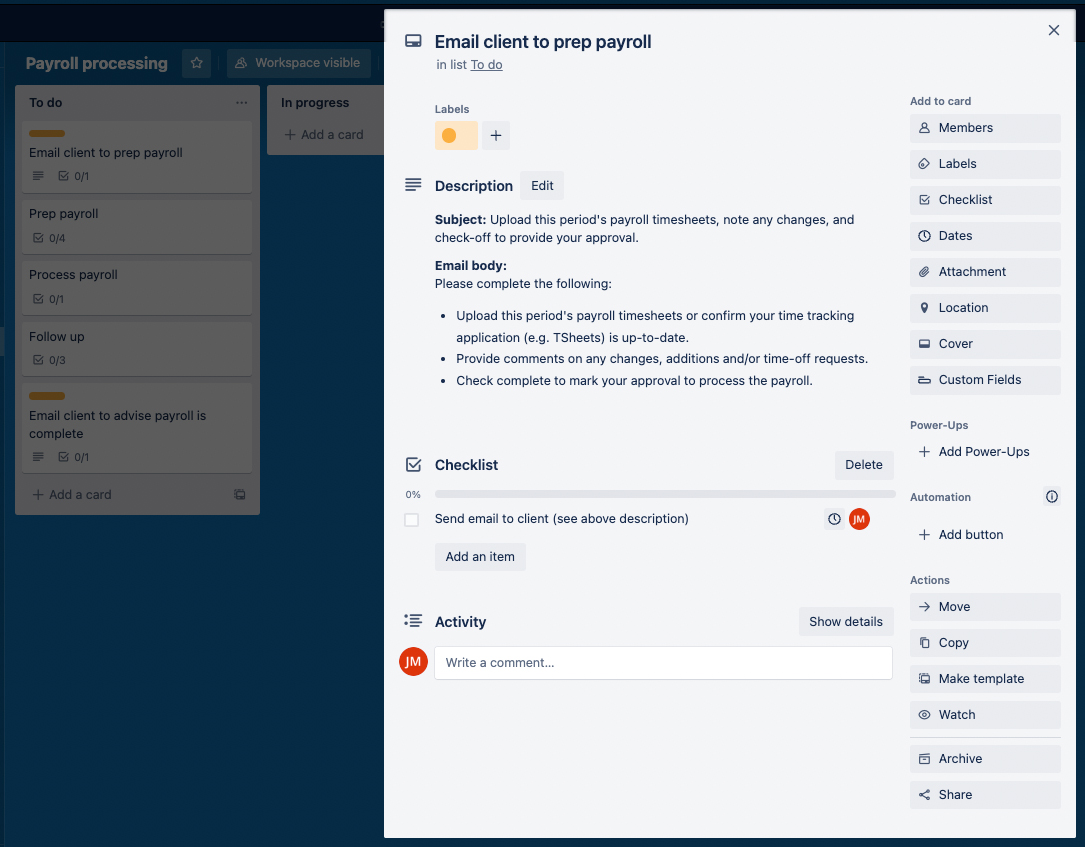
Payroll processing workflow example in Trello
Unfortunately, turning this workflow into a template isn’t available in the free version of Trello, so you will need to rename it to ‘TEMPLATE: Weekly payroll processing’ and then make a copy of that board whenever you need it. This isn't ideal when managing accounting projects.
Also, there are no out-of-the-box recurring work capabilities in Trello, so you’ll need to manually configure it using a Power-Up. Power-Ups in Trello allow you to add additional features and integrations to your projects.
The limits of Trello for accounting and bookkeeping firms
Trello’s functionality is designed to solve the problems of many, which is great news for industries with workflows that are ad-hoc and free-flowing.
But that means there’s a lot left to be desired for accounting and bookkeeping firms that have so many repeating and standard processes. Based on the above example for a common payroll processing workflow, there are serious limitations:
1. There is no way to send clients automatic reminders
For most firms, the client chase is inevitable. But that doesn’t mean it needs to be painful. In Trello, you can’t automatically send your clients reminders via email.
When your weekly payroll processing workflow kicks off with your client providing the week’s updated timesheets, you will need to continuously request this information manually until your clients provide it when using Trello.
2. Trello offers no direct email integration
Finally, after a handful of prompts from you, your client provides their weekly timesheet information. Except it’s siloed away in your email inbox.
This means you’ll be swapping between your email inbox, Trello and your payroll processing software just to complete a basic and common piece of work.
A lack of direct email integration in Trello raises other issues for accounting and bookkeeping firms:
No visibility into what emails have been sent to and from your clients in relation to a specific workflow.
No single source of truth for all communication related to any given client.
Constant switching between your inbox, CRM and Trello.
3. There are no CRM capabilities in Trello
How great would it be to automatically and directly link this particular weekly payroll processing task to your client so you can visualize all their information, work and communication easily?
For Trello users, that’s not a reality. You’d need to refer to your separate CRM solution and your email inbox to find your client’s details like:
Because of the need to constantly flip between tools, your firm’s efficiency is likely to drop if using Trello compared to accounting practice management software with email integration.
4. No native time tracking or time budgeting information available in Trello
Another example of Trello’s aim to appeal to a wide net of customers, rather than a narrow selection, is a lack of visibility over staff capacity. Especially if you’re using the free version, which doesn’t allow you to assign specific checklist tasks (or subtasks) within a card.
But being able to manage team capacity in real-time is critical for accounting firms. In Trello, it’s difficult to plan and manage capacity, and then successfully adapt when things get busy.
Plus, if you’re billing against time, you’ll need another Power Up integration with a separate time tracking tool.
5. Trello doesn’t directly integrate with accounting software
Another red flag is Trello’s extensive integration library—hundreds of options, yet none specific to accountants and bookkeepers.
There are no integrations with the tools you use every day, including GLs like Quickbooks, engagement and proposal software like Ignition, or other ecosystem apps like Dext or Gusto.
You’ll need to use Zapier and other data integration apps to set up these basic integrations.
6. There is no client portal in Trello
Offering no client portal (or similar) is another reason why Trello isn’t the ideal solution for accounting and bookkeeping firms. With Trello, you don’t have a secure location to share information with your clients and collaborate with them easily.
Again, you’ll find yourself context-switching when sending and receiving client information.
7. Customer support isn’t specific to accounting and bookkeeping firms’ priorities and nuances
Because Trello appeals to small businesses across a wide range of industries, expecting their customer support to understand specific needs of accounting professionals is unrealistic.
So unfortunately, if you use Trello and have any questions around making it work for your specific accounting workflows, you’re unlikely to find someone on their customer service team with specific accounting knowledge.
Trello alternatives for accounting and bookkeeping firms
Here is a collection of Trello alternatives that deliver on the specific needs of accounting and bookkeeping practices.
Karbon
Karbon is practice management for accounting and bookkeeping firms. By focusing on you, your industry, your clients, and all your unique requirements, Karbon is built specifically for you.
It enables intuitive communication and seamless workflows so you know who is doing what, when, why, and how.
And as a practice management system, project and task management is only one aspect of the wider Karbon offering.
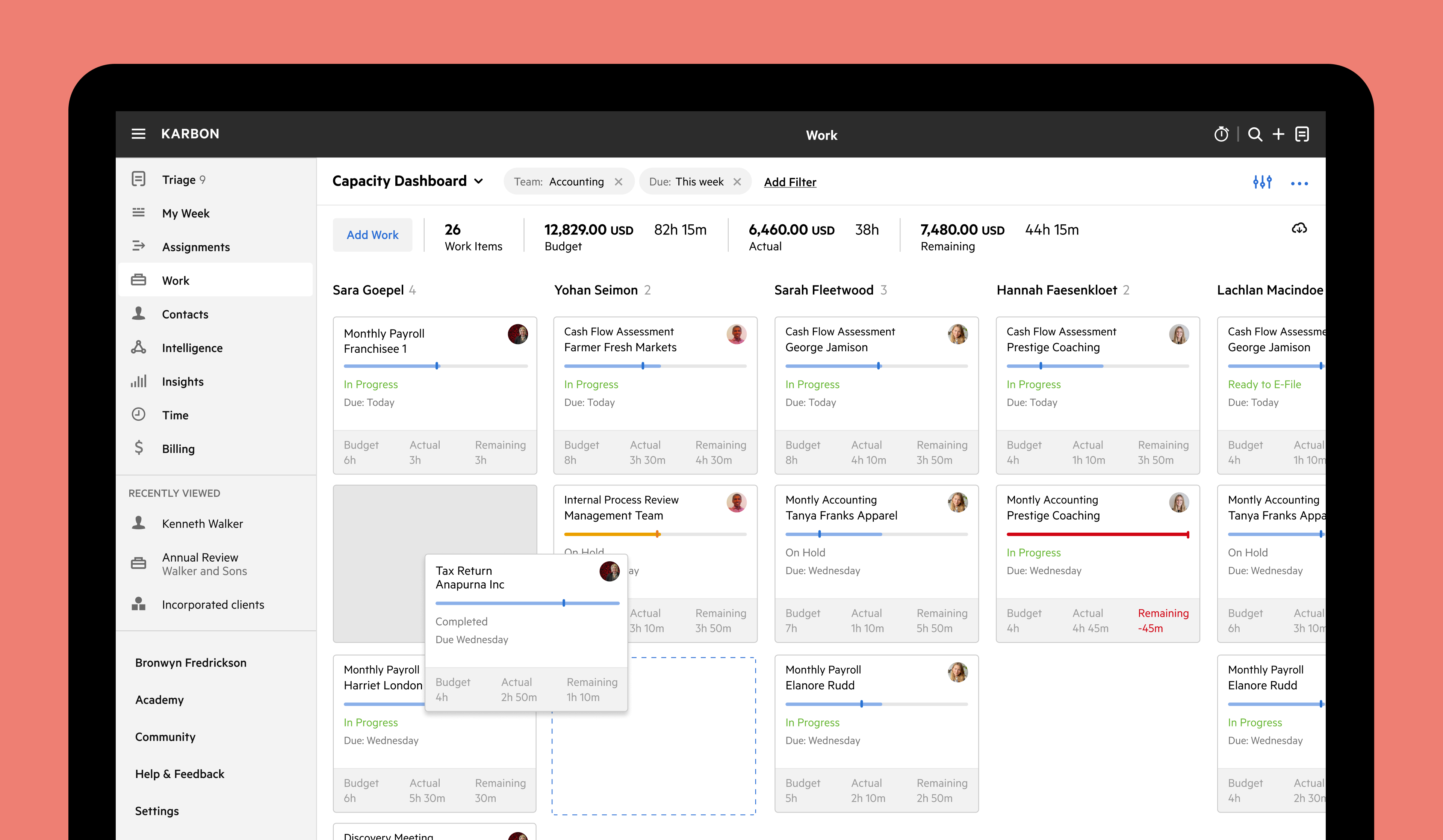
Karbon’s capacity management dashboard
Benefits of Karbon
Direct email integration (Gmail, Microsoft Outlook and Microsoft Exchange)
Built-in CRM
Automatic client reminders and client tasks
Client portal
Collaborate in context with @mentions
Template library with 280+ accounting-specific workflows
Time and budget tracking
Unlimited document storage
Document management system integration (Dropbox and OneDrive)
Invoicing and payment processing
Karbon AI: GPT-powered artificial intelligence built into email and workflows (currently in beta)
User community with 2,800+ members
Integrations that make sense for you (i.e. other leading accounting software)
Limitations of Karbon
More expensive than generic solutions like Trello
Requires more time setting up and implementing, because it is a more robust solution
Functionality is not designed for the needs of sole accountants or teams of 2-3 staff
Learn how Karbon can give you the practice management confidence you need. Book a demo.
Canopy
Like Karbon, Canopy is a practice management tool for accounting and bookkeeping firms.
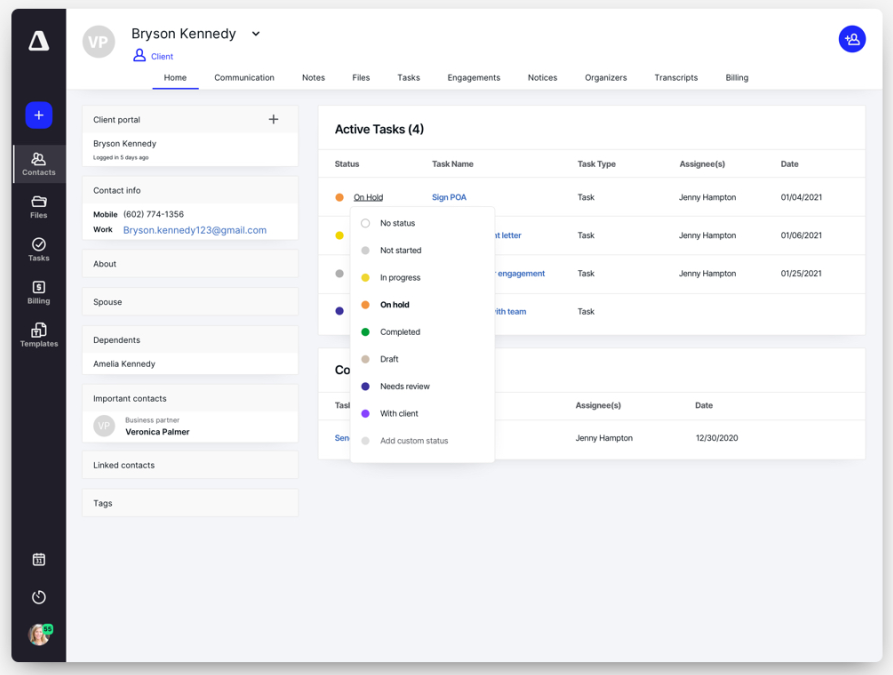
Client view in Canopy
Benefits of Canopy
Tax resolution cases and integration with IRS (paid add-on)
Flexible document and file management functionality (paid add-on)
Time, billing and invoicing capabilities
Limitations of Canopy
Key product features are only available at additional costs (e.g. workflow management and document management)
Complicated and expensive pricing (pay per client, per add-on module, per user)
Limited workflow templates
Compare Karbon and Canopy
Jetpack Workflow
As its name suggests, Jetpack Workflow provides workflow management for accounting firms. So it’s important to note that Jetpack Workflow is not a practice management solution.

Jetpack Workflow dashboard view
Benefits of Jetpack Workflow
Affordable pricing for simple workflow management
Time tracking capabilities
Useful dashboard with a high-level overview of work and your firm
Limitations of Jetpack Workflow
No email integration
Limited automation
No client portal
Compare Karbon and Jetpack Workflow
Pixie
Pixie is a practice management solution that primarily focuses on smaller firms across the UK.
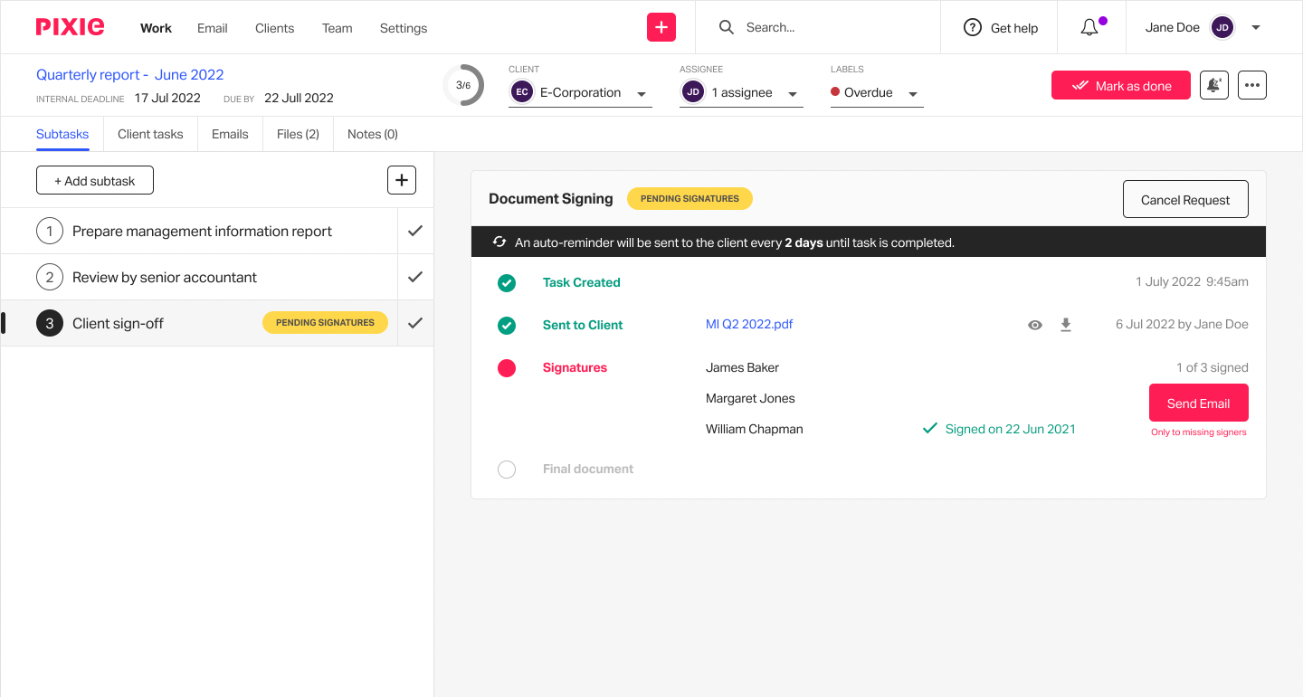
Work view in Pixie
Benefits of Pixie
Affordable solution, especially for small firms with 1-3 employees
Flexible recurring work functionality
Best-practice template library
Limitations of Pixie
Limited collaboration functionality (unable to tag colleagues in comments or notes, making teamwork difficult)
Limited automation
No time and budget tracking
Aero Workflow
Aero Workflow is another solution that provides workflow management capabilities for accounting firms. Again, it’s important to note that Aero Workflow is not a practice management solution, so it does lack in areas you need to manage your firm.

Team capacity view in Aero Workflow
Benefits of Aero Workflow
Limitations of Aero Workflow
Not a practice management solution
Lack of direction integrations
Limited automation
Not suitable for firms with 3 or more staff
Is Trello right for accounting firms?
Here’s the important question: Is Trello the right solution for accounting firms?
If you’ve just started your firm or operate as a sole practitioner, Trello may be a solution to consider. If you’re looking for a free option, it’s important to remember you won’t have access to many useful features Trello advertises, like custom fields, for example.
But as your firm grows, you will quickly outgrow Trello, especially as your firm starts to demand features of a practice management solution (rather than a project management tool).
An accounting-specific practice management tool will grow with you, your team and your firm, helping you get work done the way you need to.
Take Karbon, for example. Accounting firms using Karbon save an average of 16.5 hours per employee each week, giving them more time to focus on client relationships and growth activities.
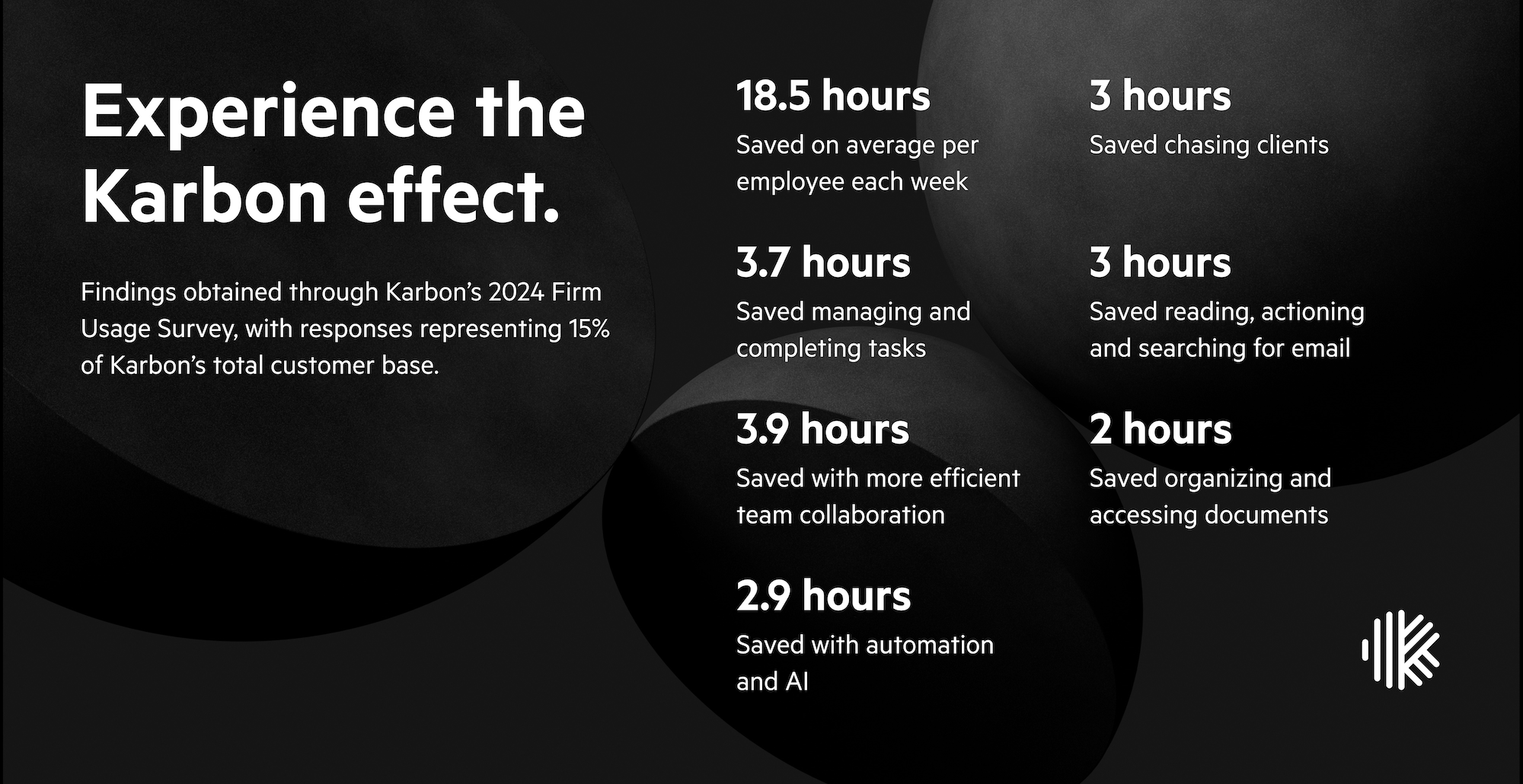
Average time and money savings for firms using Karbon
To better understand the benefits of using a practice management tool like Karbon, you can calculate your firm’s ROI using Karbon’s ROI calculator.
For example, if your firm has 20 employees, you would:
Save 858 hours per year, per employee
Save $29,824 USD per employee
Increase revenue by $455,000 USD per year
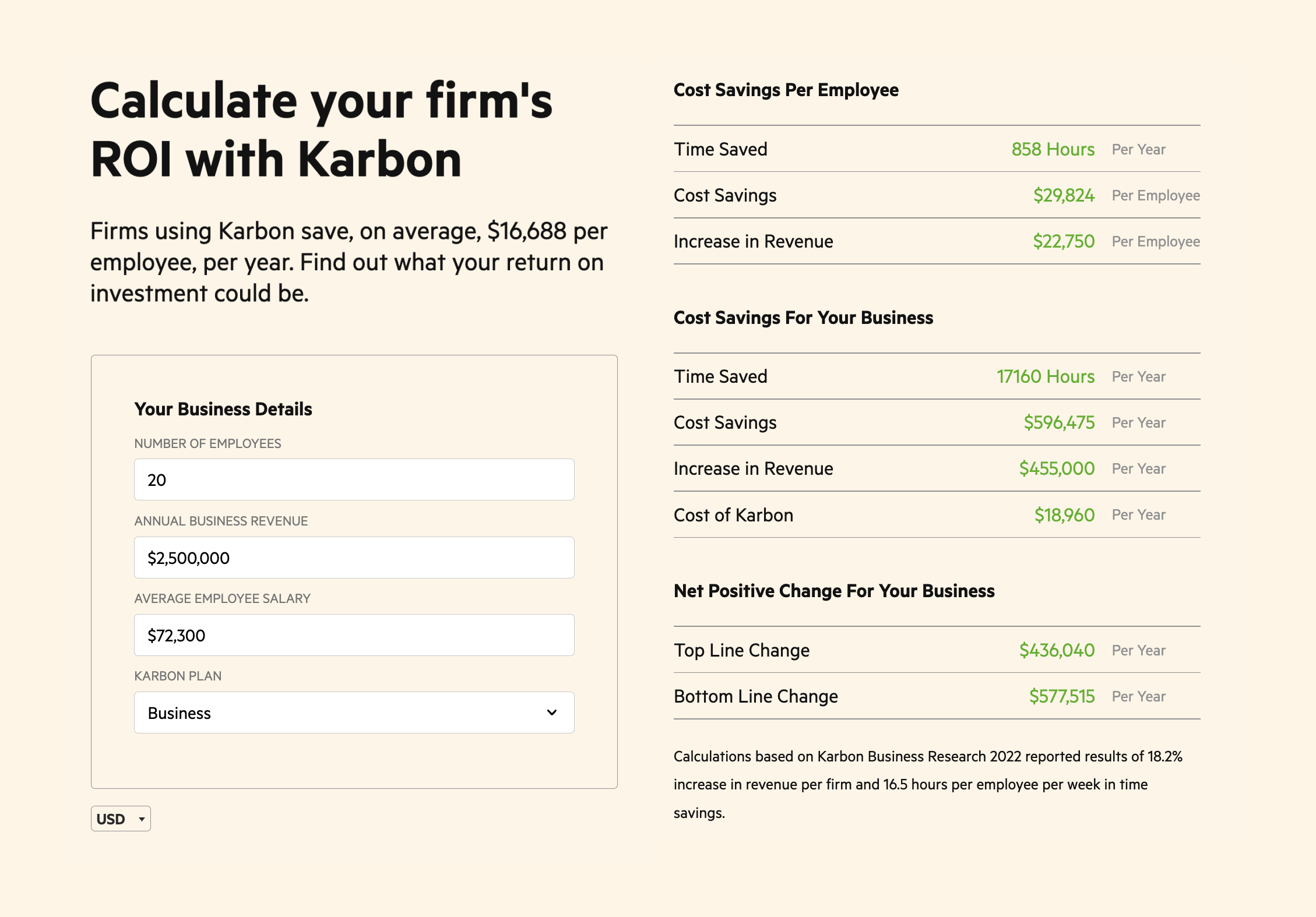
Karbon’s ROI calculator
For a more in-depth understanding of how Karbon can impact your firm’s profitability, book a demo.
Choosing an accounting practice management software platform that's right for your firm has the potential to be one of the most important decisions you can make. It’ll either set your firm up for scalable growth, or simply add to the problems you already have.
To ensure the former, start with a practice management tool that makes sense to you, your team, your firm, and your vision.









